

|
个人感觉,做嵌入式,底层就是datasheet,顶层就是数理逻辑。 不管什么芯片,当我们遇到问题时,通过查阅datasheet或上官网基本上都能找到解决方法。然而,这些基本都是英文。所以,英文好对做研发是有很大益处的。不过好在有翻译工具,如:有道(  我就是用有道划的) 我就是用有道划的)C语言虽然没有class,但有struct。我们可以多用struct。ST库和ucos中就包含许多struct。 程序结构多用状态机或switch。个人感觉,状态机看起来很有条理,很清晰,后期修改维护也方便。 鄙人浅见,请大家不吝赐教。 进入正题:UART以DMA方式接收和发送的函数调用顺序: 循环模式接收:HAL_UART_Receive_DMA(UART_HandleTypeDef *huart, uint8_t *pData, uint16_t Size)==》DMA1_Channelx_IRQHandler(void)==》HAL_DMA_IRQHandler(&hdma_usartx_rx)==》UART_DMAReceiveCplt(DMA_HandleTypeDef *hdma)==》HAL_UART_RxCpltCallback(huart) 当然这当中还会调用传输 Half 中断,这里就不讨论了。 正常模式发送:HAL_UART_Transmit_DMA(UART_HandleTypeDef *huart, uint8_t *pData, uint16_t Size)==》DMA1_Channelx_IRQHandler(void)==》HAL_DMA_IRQHandler(&hdma_usartx_tx)==》UART_DMATransmitCplt(DMA_HandleTypeDef *hdma)==》USART3_IRQHandler(void)==》HAL_UART_IRQHandler(&huart3)==》UART_EndTransmit_IT(huart)==》HAL_UART_RxCpltCallback(huart) 这里只分析 HAL_UART_Receive_DMA 的源码,其它的大家自己分析: HAL_StatusTypeDef HAL_UART_Receive_DMA(UART_HandleTypeDef *huart, uint8_t *pData, uint16_t Size) UART以DMA方式接收指定长度数据到指定缓冲区 { uint32_t *tmp; /* Check that a Rx process is not already ongoing */ if(huart->RxState == HAL_UART_STATE_READY) 检查huart->RxState是否处于 接收空闲 状态。当这一状态标志非READY时,会跳过DMA接收参数设置,直接返回HAL_BUSY。其它的UART接收函数也会检查这个状态,所以,哪个先调用就执行哪个。 { if((pData == NULL) || (Size == 0U)) { return HAL_ERROR; } /* Process Locked */ __HAL_LOCK(huart); huart->pRxBuffPtr = pData; huart->RxXferSize = Size; huart->ErrorCode = HAL_UART_ERROR_NONE; huart->RxState = HAL_UART_STATE_BUSY_RX; /* Set the UART DMA transfer complete callback */ huart->hdmarx->XferCpltCallback = UART_DMAReceiveCplt; 设置DMA传输完成的回调函数。当DMA以循环方式传输时会调用UART接收完成中断的回调函数;以Normal方式传输时会关闭UART的DMA通道,并使能UART传输完成中断,触发UART传输完成中断,设置huart->RxState为READY,并调用 UART接收完成中断的回调函数。所以,不管DMA按循环或正常模式传输,到最后都会调用UART接收完成中断的回调函数 /* Set the UART DMA Half transfer complete callback */ huart->hdmarx->XferHalfCpltCallback = UART_DMARxHalfCplt; /* Set the DMA error callback */ huart->hdmarx->XferErrorCallback = UART_DMAError; /* Set the DMA abort callback */ huart->hdmarx->XferAbortCallback = NULL; /* Enable the DMA channel */ tmp = (uint32_t*)&pData; HAL_DMA_Start_IT(huart->hdmarx, (uint32_t)&huart->Instance->DR, *(uint32_t*)tmp, Size);以中断方式打开DMA传输。所以CubeMx中DMA中断默认是打开的切不可更改 /* Clear the Overrun flag just before enabling the DMA Rx request: can be mandatory for the second transfer */ __HAL_UART_CLEAR_OREFLAG(huart); /* Process Unlocked */ __HAL_UNLOCK(huart); /* Enable the UART Parity Error Interrupt */ SET_BIT(huart->Instance->CR1, USART_CR1_PEIE); /* Enable the UART Error Interrupt: (Frame error, noise error, overrun error) */ SET_BIT(huart->Instance->CR3, USART_CR3_EIE); /* Enable the DMA transfer for the receiver request by setting the DMAR bit in the UART CR3 register */ SET_BIT(huart->Instance->CR3, USART_CR3_DMAR); return HAL_OK; } else { return HAL_BUSY; } } 下面上我做的测试:一、Cube配置 1、DMA接收要用 循环模式,只需调用一次接收函数即可,重复调用也只有第一次调用有效。若是 正常模式,需要在每次接收完成后重复调用。 2、DMA发送要用 正常模式,需在每次发送时重复调用。还要打开UART中断,否则即使重复调用DMA发送函数也只有第一次发送有效,其余不会执行(UART发送状态一直处于 BUSY)。若是 循环模式,则会连续不断地发送,不会停止。 以上两点大家可以自己改改测试。 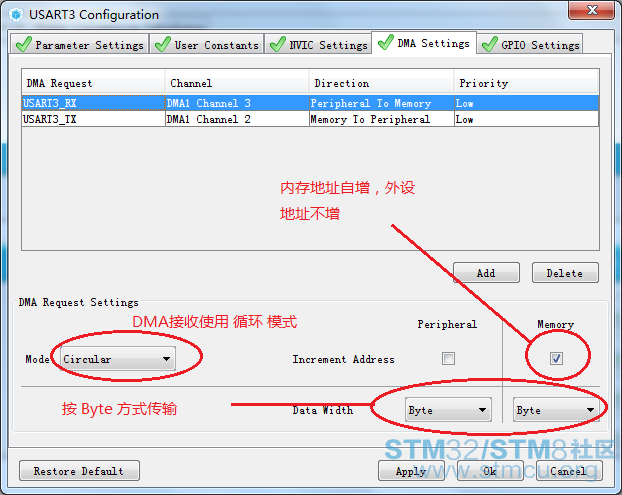
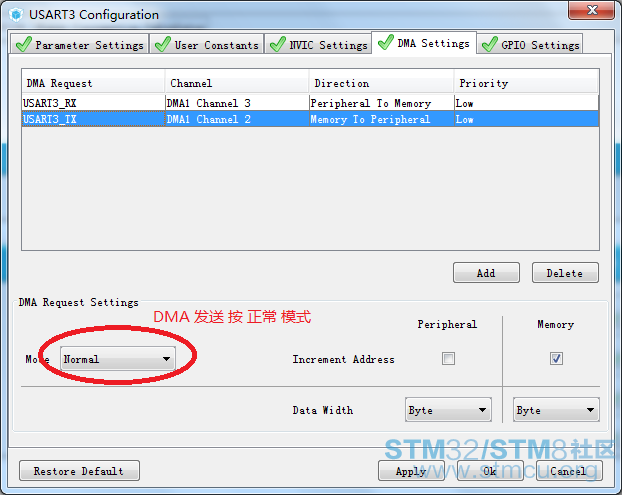

二、Keil例程编写 
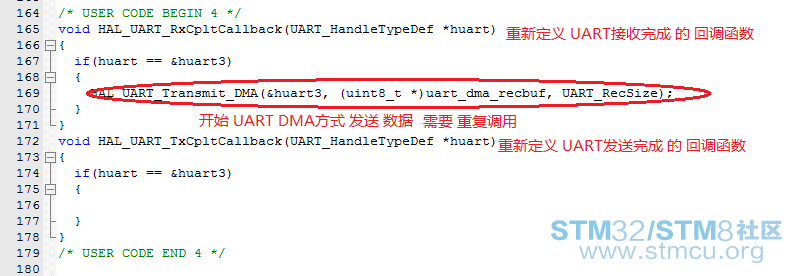
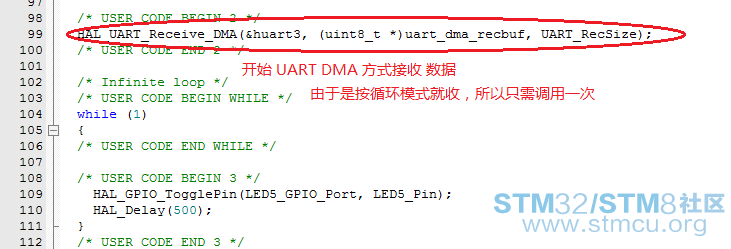
三、测试 可以看到,发送数 = 接收数。大家可以做更大数据的短间隔长时间测试,看看会不会出错。 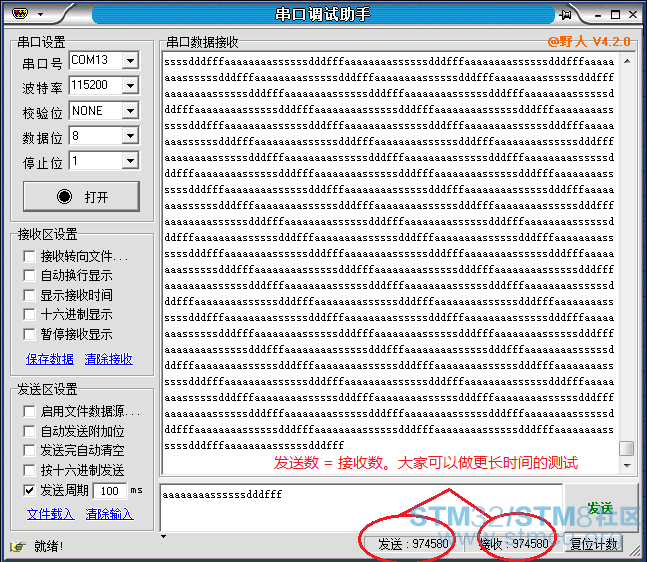
最后,奉上测试工程:  uart_dma_test.rar
(3.7 MB, 下载次数: 2111)
uart_dma_test.rar
(3.7 MB, 下载次数: 2111)
|
 微信公众号
微信公众号
 手机版
手机版

"no source": Error: #5: cannot open source input file "C:/Users/Administrator/STM32Cube/Repository/STM32Cube_FW_F1_V1.6.0/Drivers/STM32F1xx_HAL_Driver/Src/stm32f1xx_hal_rcc.c": No such file or directory
https://www.stmcu.org.cn/module/forum/thread-614550-1-1.html